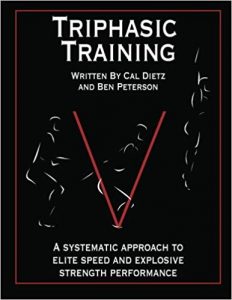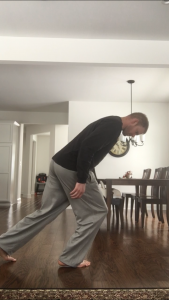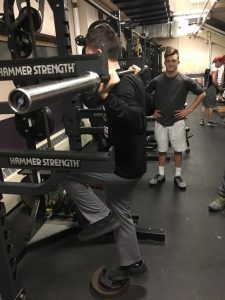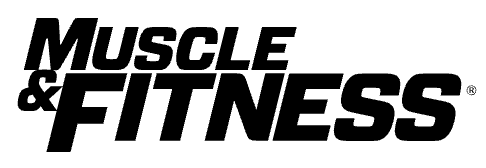Isometrics For Athletic Performance
Iso’s- if you are familiar with the term, chances are that word conjures up anxious sweat and quaky limbs. I was first introduced to the agonizing sear of isometric training during my college football days. Put bluntly, the season is a bear. Four months of two-three hour practices, watching film, academic work and diets that are usually less than ideal can shrink even the most robust of frames. Physiques that were jacked and tan in August withered to pale and frail by November. With this loss of size driving our collective psychology, once the season concluded we plowed head first into the world of iron, chalk and pain.The priority was to add size, clang some weights and if I’m being honest-try to impress the co-eds in the fitness center with our homemade cut off Ts and puka shell necklaces (ah early 2000’s).

Sad but true
As a team bonding experience it was a galvanizing force. Our shared misery brought us closer and forged stronger bonds throughout the squad. As a performance based system, well, it had more holes than a block of Swiss at a mouse farm. Not enough rest, not specific enough and tip toeing at the edges of actually causing injury.
One of the more memorable stops of our plyo circuits were the iso hold stations. Here, we would attempt to hit a specific position in a lunge, squat, pushup or plank and fight it for time. It was miserable. Already in a state of zombified fatigue from the previous stations, we now were attempting to hold these spots as our bodies were imploding like the Tacoma Narrows Bridge.

Galloping Gertie didn’t last long
Fast forward a couple trips around the sun and I hear Cal Deitz-the head strength coach at the University of Minnesota speak about his new book Tri-phasic training. In it, he explains how isometric contractions are the forgotten pathway to moving dynamically and explosively. I’m intrigued. I always assumed that just lifting heavier would help with everything. Now I find out just slapping more weight on your bench and squat might not be the end all, be all in moving better on the field of play.

Hundreds, if not thousands of coaches have picked up gems from this well known book.
Look at any athletic movement- be it running, jumping or cutting and you will see a blend of the three muscular contractions-eccentric, concentric and isometric. In eccentric, the muscle lengthens under tension. Think of the descending portion of a bench press or the counter movement of a jump. It essentially is the slowing down or resisting element of a muscular contraction. This is huge in preventing injury and resisting outside forces in play.
In concentric, the muscle shortens under tension. Think of curling a set of dumbbells up to your chin or running past someone on the soccer field. It essentially is the overcoming/explosive element of a muscular contraction. This is huge in the “wow” factor in sports; the big jump and the violent swing are all concentric animals.
In isometric, the muscle stays the same length under tension. Think of it as the split second transfer between the eccentric yield and the concentric pop. The stronger (or stiffer) the isometric, the bouncier/faster or more violent the movement becomes. One of my favorite analogies in describing this is in looking at an inflated basketball getting bounced vs. a deflated basketball. When the inflated ball hits the ground it is able to use the force from the descent and transfer it to a high bounce. Nothing is wasted.
Now think about what happens when you try to bounce a deflated ball. No stiffness, no strong iso, when it hits the ground, it bounces nowhere. Not ideal athletically. For me, I want my athletes to be like an inflated superball coated in flubber. When that foot hits the ground, BOOOOOM! No loss of energy, just pure elastic recoil. One of the best ways to train this quality is through jumping and sprinting with maximal intent. But, there are a few choice exercises that can train the position you are trying to enhance and they can be supplemented by strong isometric holds.
This list is scratching the surface of the world of the iso, but here Ill focus on three different isometric holds and the reasoning for working these particular positions.
Iso single leg lunge
Unilateral lower body strength work has become a sexy topic in the world of strength and conditioning. A couple reasons for this include the facts that we run on one leg-not two, it seems to spare low backs more than the bilateral lower body options and lastly it generally is easier to teach single leg movements than double leg ones. With those factors at play the iso single leg lunge is a great option for training different positions in acceleration and maximal speed. Depending on the moment in the gait cycle the leg angles can differ, so you can play around with different positions here, too.
How long we hold these…well it depends. But it should not be unreasonable for a high school level athlete to lock into these positions for a minute. In older trainees I have seen 5 minutes prescribed, but lets remember this is all context specific.
 More of an acceleration look here. Knee will drift over the toe, tension in the forefoot.
More of an acceleration look here. Knee will drift over the toe, tension in the forefoot.
 More of a maximal velocity look here. Knee will stay back more than acceleration. Straighter back leg/greater hip flexor stretch
More of a maximal velocity look here. Knee will stay back more than acceleration. Straighter back leg/greater hip flexor stretch
Iso 1 leg pin smash
While the first two examples require nothing more than your body, the floor and (potentially) some outside resistance, this little number is a little more complicated in terms of the set up. The posture we are trying to hit here is when the foot touches down in maximal velocity sprinting. This requires a rack, bar, some crash pins and a weight plate or two to drive into. Stack a 10-25 pound plate or two on the floor inside the power rack. Once that is accomplished the next part in the setup of this exercise is setting the crash pins at an appropriate height for the athlete.

Keep the heel up, blast through the forefoot and stand tall
While this list isn’t exhaustive, this can get you thinking about adding some isometric work into your current program and moving better out there in your sport.


